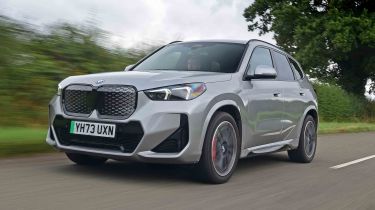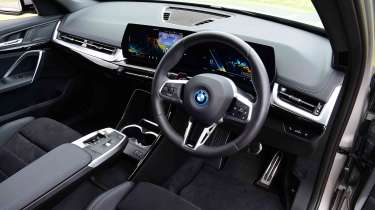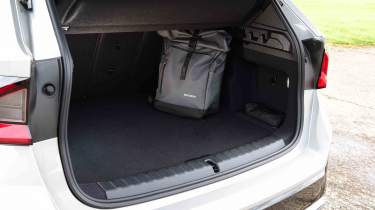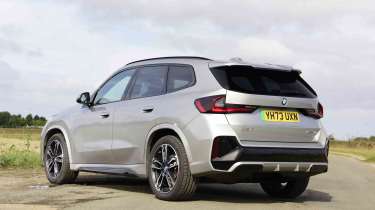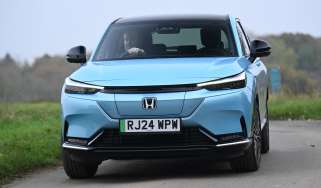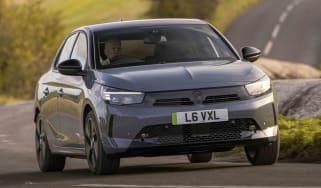BMW iX1 review
The BMW iX1 is a strong all-rounder that has premium and mainstream SUVs in its sights

Is the BMW iX1 a good car?
As it stands, the BMW iX1 is the smallest EV in the German firm’s range. That doesn’t mean it has much in common with the i3 that was previously the most compact model offered. While that was an innovative, smartly designed small car, the iX1 instead takes aim at the popular compact SUV crowd.
That means it’s up against not only the likes of the Tesla Model Y, Audi Q4 e-tron and Volvo EX40, but also similarly sized, more mainstream alternatives such as the Skoda Enyaq and Peugeot E-3008. There’s the mechanically similar, but more stylised, MINI Countryman to contend with, too.
| Key specs | |
| Fuel type | Electric |
| Body style | Five-door, five-seat compact SUV |
| Powertrain | Single motor, 66.5kWh battery, front-wheel drive Dual motor, 66.5kWh battery, four-wheel drive |
| Safety | 5-star Euro NCAP (2022) |
| Warranty | 3yrs/unlimited miles |
BMW iX1: model range, specs and rivals
While the BMW iX1 is an offshoot of the standard X1 line-up, there are a variety of models available. The range starts from around £46,000, which is roughly £11,000 more than the asking price for the entry-level X1. There are front and four-wheel drive powertrains on offer, while the trim levels mirror those of the standard X1, with Sport, xLine and M Sport options available.
There’s just one body style, a five-door, five-seat compact SUV - if you want something different, then there’s the all-electric BMW iX2, which shares the same underpinnings but has a coupe-SUV body.
All models come with LED lights front and rear, alloy wheels, a powered tailgate, twin digital displays using BMW’s Operating System 9 with navigation and smartphone connectivity, two-zone climate control, three driving modes, front and rear parking sensors, a reversing camera and cruise control.
An upgrade to xLine trim for around £2,000 extra adds 18-inch wheels (up from 17 inches on the Sport model), artificial leather upholstery, gloss black interior trim and upgraded instruments. On top of that, the M Sport is another £3,000 extra and features a subtly sportier bodykit, a different 18-inch wheel design and M-specific design details inside and out, while adaptive M suspension is also added.
The front-wheel drive iX1 uses the eDrive20 monicker, and features a single electric motor making 201bhp. The xDrive30 is more powerful, with a dual-motor set-up making 309bhp and sending power to all four wheels. Both cars feature a 66.4kWh battery, which is relatively small when compared with some rivals - an Audi Q4 e-tron uses 88kWh batteries, for example.
How much does the BMW iX1 cost?
BMW iX1 prices start from £46,205 and go up to £56,875. The Auto Express network of trusted dealers is currently offering discounts on those recommended retail prices of up to £10,721 via our Find a Car service. Alternatively, you can lease a BMW iX1 from around £297 per month.
Motors, performance and drive
When choosing an iX1, it’s well worth considering just how much you want to chase the style you get with the M Sport’s large wheels and sports suspension, because it results in a very hard ride. It’s bordering on the sort of firmness that buyers would expect from a hot hatchback, so it can start to feel a little wearing in a family car while you’re just trying to take a relaxed daily commute.
Choose xLine trim or the lower Sport (only available with the eDrive20 powertrain) and the standard suspension setting and smaller wheel sizes help to take the edge off. Even so, if you value comfort, then the Audi Q4 e-tron is still a much better option.
The iX1’s brakes offer reassuring feel and a smooth transition between the motor regeneration and the mechanical system kicking in. There are three choices of regen to choose from, but they’re a little fiddly to adjust because they’re chosen via the infotainment system, as opposed to the more intuitive paddles that some rivals employ. There’s also an adaptive regen system, which uses navigation and traffic data to decide how much regen to use, but like all systems of this type, it’s inconsistent and unpredictable.
The flipside of this is that the BMW handles more sharply than most of the alternatives in this segment. This is all relative, though; as a heavy, electric SUV, it’s still not going to set pulses racing in the way that some of BMW’s other products can. Even its larger offerings, like the iX, manage to deliver decent handling with class-leading comfort – something the iX1 can’t achieve.
The steering is very precise and offers a little feedback to the driver – even if, more often than not, that is just to let the driver know that the front tyres are reaching the limits of their grip.
Regardless of whether you go for the single or twin-motor model, the power delivery is very smooth, providing a sharp throttle response without overwhelming the traction of the front tyres. A ‘Boost’ paddle to the left of the steering wheel gives you maximum power for 10 seconds, but in the eDrive20 we noticed little to no difference between pulling the paddle and simply pushing the accelerator pedal as far as it’ll go.
Motor refinement and wind noise are fairly well contained at higher speeds, which means that road noise is the most conspicuous sound you hear. It’s not unnecessarily harsh, though, more of a distant bassy rumble; it’s only marginally louder than the likes of the Q4 and is quieter than the Mercedes EQA and Tesla Model Y.
| Model | Power | 0-62mph | Top speed |
| iX1 eDrive20 | 201bhp | 8.2 seconds | 106mph |
| iX1 xDrive30 | 309bhp | 5.6 seconds | 112mph |
0-62mph acceleration and top speed
The entry-level eDrive20 uses a single front-mounted motor that produces 201bhp and 250Nm of torque, which is good for a 0-62mph time of 8.2 seconds. Above that sits the twin-motor, four-wheel-drive xDrive30. Output climbs to 309bhp and 494Nm, which is enough to slash three seconds from the eDrive20’s 0-62mph time. Both models use the same 66.4kWh (net) battery pack, which is smaller than the class average.
If you’d like, acceleration can be accompanied by a sci-fi-esque feedback noise provided by film composer Hans Zimmer, which works surprisingly well. Behind the steering wheel is a single, left-hand paddle, which engages the ‘boost’ mode, allowing the electric motors to deliver their full potential for 10 seconds.
Range, charging and running costs
We have run a BMW iX1 on our long-term fleet and over a wide mix of urban motorways, A-roads and town driving, it averaged 3.7 miles per kilowatt hour.
Charging at the current UK electricity price cap of 22.4p per kilowatt hour, that would mean 10,000 miles of charging would come to £604. Those who are able to charge via a cheaper energy tariff can pay even less, while those who regularly top up at expensive public rapid charging points could pay significantly more.
With a net capacity of 66.4kWh, the iX1’s battery is a little smaller than most of its key rivals. Based on our test efficiency, that means that the iX1 is capable of 246 miles between charges, which is a little low compared with the class standard, but still plenty for all but the longest road trips.
When it comes to topping up the battery in a hurry, a maximum charge rate of 130kW is a fair bit slower than rivals such as the Tesla Model Y (at 250kW), too.
The zero-emission powertrains mean that the iX1 isn’t subject to Vehicle Excise Duty charges, while its two per cent rating for Benefit-in-Kind costs makes it a cheap option for company car drivers, too – higher-rate income tax payers can expect deductions
of just £369 this year, increasing to £554 in the 2025/26 financial year.
Groups start from 29 for the entry-level iX1 eDrive20 Sport and climb to 38 for the xDrive30 M Sport, which is considerably lower than the ratings for a Tesla Model Y in comparison.
Residual values aren’t really a BMW iX1 strong point, but some rivals fare worse than others. After three years or 36,000 miles, the iX1 that will be the most resistant to depreciation will be the base eDrive20 Sport, which will cling onto 45 per cent of its original price. The xDrive30 M Sport loses more money, maintaining an estimated 41 per cent of its value over the same period.
The Audi Q4 e-tron and Volvo EX40 depreciate more, but the Tesla Model Y holds on to its value better.
To get an accurate valuation for a specific model, check out our valuation tool...
| Model | Battery size | Range | Insurance group |
| iX1 eDrive20 Sport | 66.4kWh | 293 miles | 29 |
| iX1 xDrive30 xLine | 66.4kWh | 270 miles | 37 |
Interior, design and technology
Many of BMW’s latest creations have divided opinion when it comes to looks, but the brand has played things slightly more safely with the iX1. Large grille aside, the general shape is sharply styled yet chunky enough to appeal to the SUV crowd. Wheel sizes range between 17 and 20 inches – the latter a £1,530 option on M Sport models. In terms of design, ergonomics and quality, the iX1’s cabin ranks close to the top of the class.
BMW’s interior designers have been on top form in recent years, and the iX1 is yet another hit for the brand. It offers a modern, clean interior design without completely sacrificing physical switchgear and controls. It’s a shame that the iDrive click wheel, still used on larger BMWs, is not present here, but for the most part the cabin controls are simple and intuitive to use.
There are other little touches that are well thought out; the wireless smartphone charging pad is near vertical on the dash to not take up too much space, and a small hinged bar secures the phone so it doesn’t move around while driving.
The firm’s interior quality still leads the way almost universally across the board, and the iX1 feels more sturdy than its rivals in this segment, too. The materials are top notch and what little switchgear there is feels solid and expensive.
A pair of displays curve gently across the top of the dash, and both have a superbly sharp resolution. The colours change subtly among the driving modes, but we find that the angular layouts for the road speed and charge levels look a little fussy compared to the beautifully clear and simple analogue BMW dials of the past.
Sat-nav, stereo and infotainment
At 10.25 inches, the iX1’s main screen isn’t as large as a Tesla Model Y’s, but a second 10.7-inch display ahead of the driver caters for functions that are crammed onto the Tesla’s single screen, so they feel a little more spaced out and the on-screen buttons are often larger. The resolution is at least as sharp as its rival’s display, too, and although it’s a shame that the climate controls are on-screen only, the arrangement isn’t as fiddly as many other rivals’ set-ups.
Boot space, comfort & practicality
The front seats and steering wheel come with plenty of adjustment, although as with most other BMWs, the wheel rim is a little thicker than in most rivals, which makes it feel slightly less precise than in most other competitors.
Storage is fairly impressive here, too, with large trays located beneath the floating centre console, and a couple of cup-holders mounted farther forward.
Our one small gripe is that the central armrest storage area is hinged away from the driver, as if it were designed for left-hand-drive markets and no one bothered to change it for right-hand-drive cars. BMW isn’t unique in doing this, however.
In terms of headroom and elbow room, the iX1 is as spacious as anything else in the segment, and the adjustable backrest can recline into a more relaxed position for longer trips.
The BMW lags ever so slightly behind the competition when it comes to kneeroom, where it’s not quite at SUV levels, and there is less space to stretch out than you’ll find in the back of a 3 Series. The floor has only a minimal hump in the centre, so there’s still plenty of foot room even if three people are sitting in the back. The base of the centre seat is soft, but the backrest, which doubles as a fold-out armrest, is a little firm.
Installing a child seat is straightforward, because the ISOFIX mounts are easy to reach behind hinged plastic clips. The rear door bins are huge, too – ideal for drinks bottles and mobile devices – so it’s great for storage.
At 490 litres measured to the window line, the iX1’s boot is a generous size, if not quite class-leading. Fold the back seats down, and the volume grows to 1,495 litres when you fold down the 40:20:40-split rear seats.
Unlike the Tesla Model Y, there’s no separate storage under the bonnet for items such as cables or soft bags .
| Dimensions | |
| Length | 4,500mm |
| Width | 1,845mm |
| Height | 1,642mm |
| Number of seats | Five |
| Boot space | 490-1,495 litres |
Reliability and Safety
The petrol-powered X1 bagged a five-star rating when it was tested by Euro NCAP back in 2022, and the safety body confirmed this score applied to the all-electric iX1 when it was assessed separately in 2023. An impressive score of 92 per cent in the Safety Assist category was its strongest rating.
A 14th-place finish out of 32 brands left BMW mid-table in the 2024 Auto Express Driver Power satisfaction survey, but that was comfortably good enough for it to beat Mercedes (25th) and Audi (27th). BMW owners said they particularly loved the powertrains, chassis and infotainment tech.
| Key standard safety features | Euro NCAP safety ratings |
|
|
Warranty
BMW offers a three-year, unlimited-mileage warranty on all of its range, including the iX1, which is par for the course. Three years of breakdown cover is also provided.
Servicing
Service intervals are set at every two years, which keeps costs down relative to the equivalent petrol-powered X1 models. This works out as £512 over the first three years for the iX1.
BMW iX1 alternatives
The list of rivals for the iX1 is a veritable who’s who of the premium family EV segment, with some coming from within the BMW empire. If you want to pay more for a car with less space, then the iX2 uses the same running gear, while the MINI Countryman is arguably more versatile than the iX1.
Elsewhere, the recently updated Volvo EX40 (formerly known as the XC40 Recharge), its coupe-esque EC40 sister car, the Audi Q4 e-tron and Mercedes EQA. High-spec versions of the Hyundai Ioniq 5, Kia EV6, Nissan Ariya and Tesla Model Y fall into the same price range as the iX1. They all offer more range and most of them have more boot space too, although they’re more openly EVs than the iX1.
BMW iX1 long-term test
Our news reporter, Ellis Hyde, struggled to develop any real bond with the BMW iX1 during his six months with the electric SUV. While there are certainly plenty of qualities that day-to-day buyers will find desirable, Ellis couldn’t help but feel that things were noticeably lacking in the fun department. On the plus side, though, Ellis was left feeling highly impressed by BMW’s dealership customer service after a slight mishap involving some standing water. You can read the full long-term test here…
Frequently Asked Questions
During our time running an iX1 eDrive20, we saw a return of 3.7 miles per kWh over a variety of driving conditions. That means a range of 246 miles is possible, which is around 50 miles short of the best claimed range that BMW quotes. However, look at any of the iX1’s rivals, and you’ll see a similar shortfall in real-world conditions.
